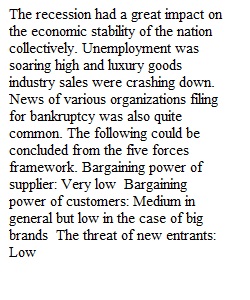


Q Introduction Pumping out fancy clothing, handbags, jewelry, perfumes, and watches, the high end of the fashion industry - otherwise known as the luxury goods industry - had a challenging time in the Great Recession. Assignment Chapter 2 Closing Case - High Fashion Fights Recession In Chapter 2 Closing Case - High Fashion Fights Recession. Answer the questions listed at the end of the case. Students will be expected to utilize information learned, experience, research, and your critical thinking skills to respond to this assignment. Your detail response must be clear, concise, and meet the minimum two-page, double-spaced response criteria. Please upload your paper for grading when completed. Due Date: October 24, 2021 Instructions • Write a minimum two-page paper on your response to the assignment question. • Your detail response must be clear, concise, using your critical thinking skills. • Review the Submission Guidelines before uploading your paper. • Upload your paper for grading when completed.
Q 1) Using the Five Forces Framework, how would you characterize the competition in the luxury goods industry?2) How much bargaining power did consumers as buyers have during the Great Recession?3) Why was discounting looked down upon by industry peers, all of which were differentiated or focus competitors?4) What would be the likely challenges in emerging markets for luxury goods firms?
View Related Questions